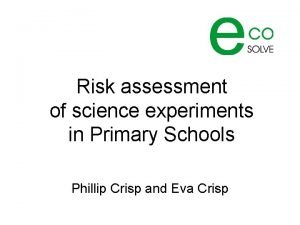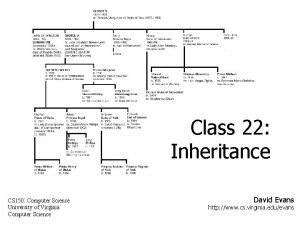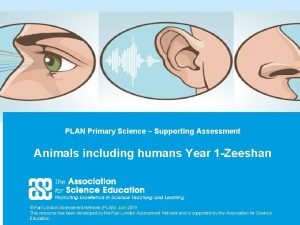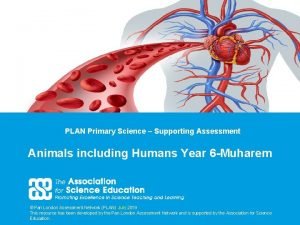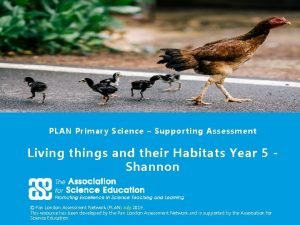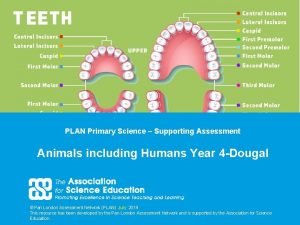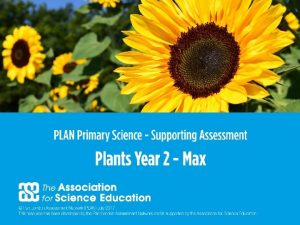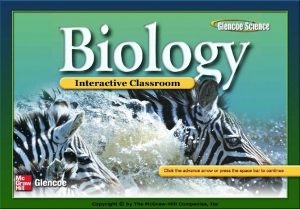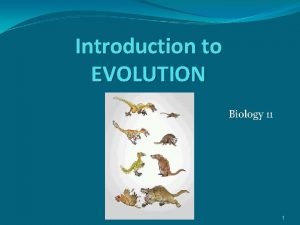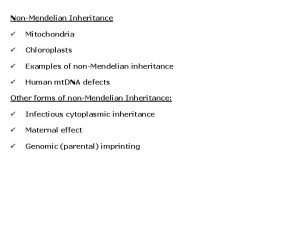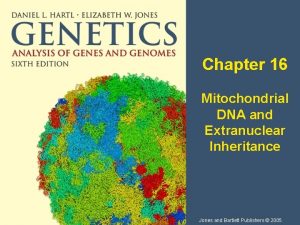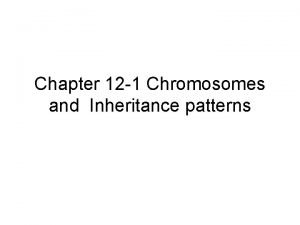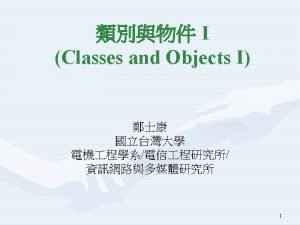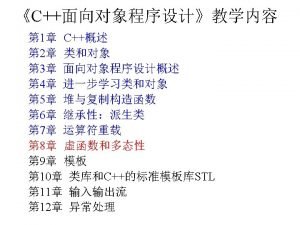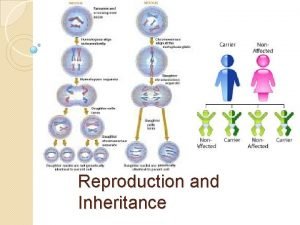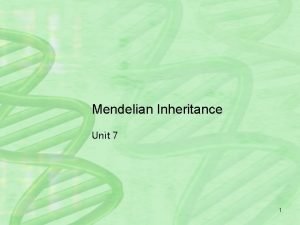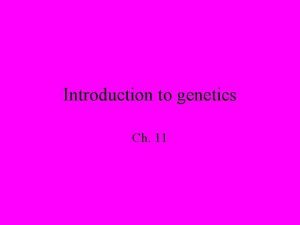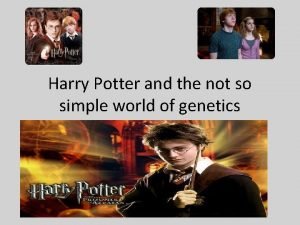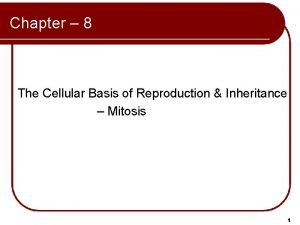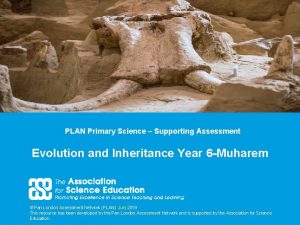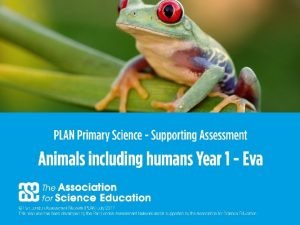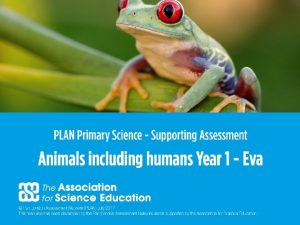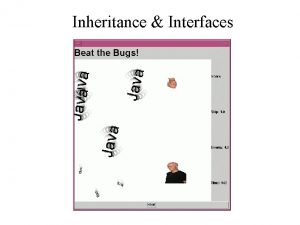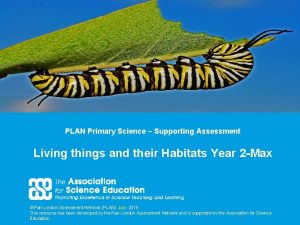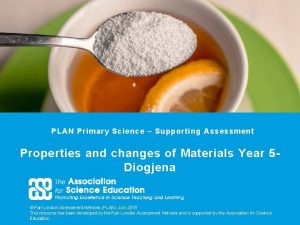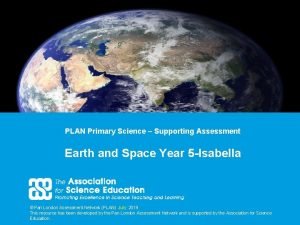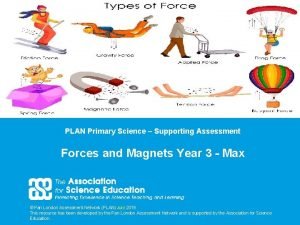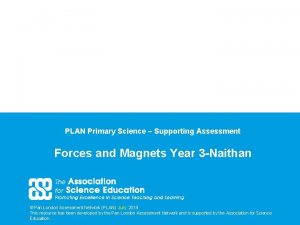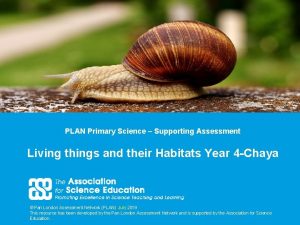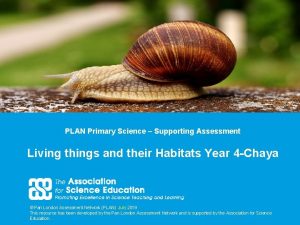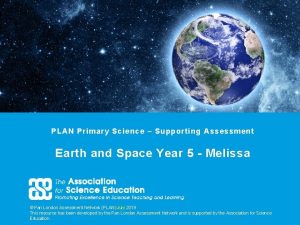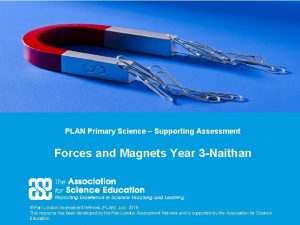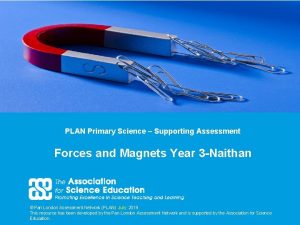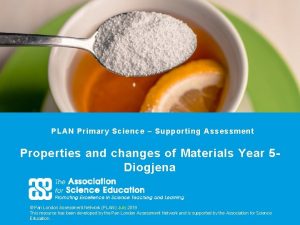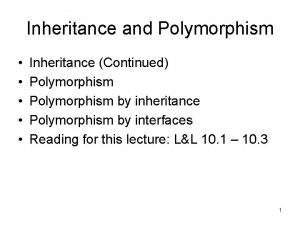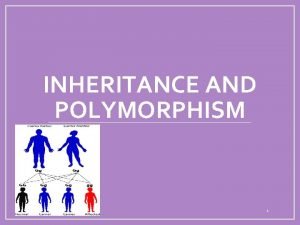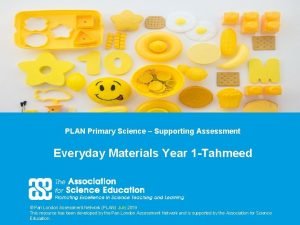PLAN Primary Science Supporting Assessment Evolution and Inheritance

























- Slides: 25

PLAN Primary Science – Supporting Assessment Evolution and Inheritance Year 6 -Muharem © Pan London Assessment Network (PLAN) July 2019 This resource has been developed by the Pan London Assessment Network and is supported by the Association for Science Education. 1

PLAN Primary Science - Supporting Assessment PLAN Primary Science is a set of resources produced to enable teachers to have a clearer understanding of National Curriculum expectations for meeting the standard. Annotated collections of children’s work provide examples of what working at the expected standard for primary science might look like for the knowledge and conceptual understanding statements of the programmes of study (POS). It is not the intention of these resources to specifically exemplify the working scientifically statements. However, aspects of working scientifically have been shown as an integral part of the teaching and learning of the knowledge and concepts. The resources provided have been cross moderated multiple times before publishing so that they can be used with confidence by teachers and subject leaders. Each collection of work shows one example of how a pupil has met National Curriculum statements for a particular area of content but these are not intended to be the definitive way of teaching these statements. 2

Structure of the resources Each resource contains the relevant National Curriculum statements for the unit of work and prior learning, a planning matrix, annotated work and a summary sheet. The matrix provides an interpretation of the key learning of the National Curriculum statements, and suggestions of key vocabulary. In order to be meet the expectations pupils must firstly understand the key concept and then be provided with opportunities to apply that knowledge. This is a key planning tool. Key Learning Secure Possible Evidence Show Overview paragraph describing understanding of a curriculum concept by using scientific Key vocabulary – list of words vocabulary correctly Possible ways to demonstrate key learning, particularly correct usage of vocabulary Apply knowledge Suggestions of contexts to use. in familiar related contexts, including a range of enquiries Possible ways to demonstrate that a pupil has gone beyond recall of facts and can apply the key learning, for example using the vocabulary and basic principles to produce explanations, usually within Working Scientifically contexts. 3

Contents of the materials Please note: The NC statements for each topic area for the relevant year group are stated on the slide. Only the statements in bold on that slide have been exemplified. In these cases the teachers have chosen to split the statements within the topic area to teach at different times. The prior NC statements relevant to the topic area are also stated and use to determine pupils’ knowledge at the start of the unit. Each slide has been annotated with coloured text. Please see key below: Red Commentary to explain how evidence meets/does not meet NC statements Blue Commentary to highlight features of working scientifically Green Pupil Speak Grey Other relevant information eg. vocabulary used 4

Year 2 Statements Year 2 statements – prior learning Pupils should be taught to: • identify that most living things live in habitats to which they are suited and describe how different habitats provide for the basic needs of different kinds of animals and plants, and how they depend on each other (2 -Living things and their habitats) 5

Year 3 Statements Year 3 statements – prior learning Pupils should be taught to: • describe in simple terms how fossils are formed when things that have lived are trapped within rock (3 -Rocks) 6

Year 4 Statements Year 4 statements – prior learning Pupils should be taught to: • recognise that environments can change and that this can sometimes pose dangers to living thing (4 -Living things and their Habitats) 7

Year 6 Statements Year 6 statements Pupils should be taught to: • recognise that living things produce offspring of the same kind, but normally offspring vary and are not identical to their parents (6 -Evolution and inheritance) • identify how animals and plants are adapted to suit their environment in different ways and that adaptation may lead to evolution (6 -Evolution and inheritance) • recognise that living things have changed over time and that fossils provide information about living things that inhabited the Earth millions of years ago (6 -Evolution and inheritance) 8

Later Statements Pupils do not need to be taught content they will learn in later year groups. They can be challenged by applying the content for their year group in broader contexts. Pupils in Key Stage 3 will be taught about: • heredity as the process by which genetic information is transmitted from one generation to the next • a simple model of chromosomes, genes and DNA in heredity, including the part played by Watson, Crick, Wilkins and Franklin in the development of the DNA model • the variation between species and between individuals of the same species means some organisms compete more successfully, which can drive natural selection • changes in the environment may leave individuals within a species, and some entire species, less well adapted to compete successfully and reproduce, which in turn may lead to extinction

Key learning Possible Evidence Shows understanding of a concept using scientific vocabulary correctly All living things have offspring of the same kind, as features in the offspring are inherited from the parents. Due to sexual reproduction, the offspring are not identical to their parents and vary from each other. Plants and animals have characteristics that make them suited (adapted) to their environment. If the environment changes rapidly some variations of a species may not suit the new environment and will die. If the environment changes slowly, animals and plants with variations that are best suited survive in greater numbers to reproduce and pass their characteristics on to their young. Over time these inherited characteristics become more dominant within the population. Over a very long period of time these characteristics may be so different to how they were originally that a new species is created. This is evolution. Fossils give us evidence of what lived on the Earth millions of year ago and provide evidence to support theory of evolution. More recently scientists such as Darwin and Wallace observed how living things adapt to different environments to become distinct varieties with their own characteristics. Key vocabulary Offspring, sexual reproduction, vary, characteristics, suited, adapted, environment, inherited, species, fossils Can explain the process of evolution Can give examples of how plants and animals are suited to an environment Can give examples of how an animal or plant has evolved over time e. g. penguin, peppered moth Give examples of living things that lived millions of years ago and the fossil evidence we have to support this Can give examples of fossil evidence that can be used to support theory of evolution Applying knowledge in familiar related contexts, including a range of enquiries Design a new plant or animal to live in a particular habitat Use models to demonstrate evolution e. g. Darwin’s finches bird beak activity Use secondary sources to find out about how the population of peppered moths changed during the industrial revolution Make observations of fossils to identify living things that lived on Earth millions of years ago Identify features in animals and plants that are passed on to offspring Explore this process by considering the artificial breeding of animals or plants e. g. dogs Compare the ideas of Charles Darwin and Alfred Wallace on evolution Research the work of Mary Anning and how this provided evidence of evolution Can identify characteristics that will make a plant or animal suited or not suited to a particular habitat Can link the patterns seen in the model to the real examples Can explain why the dominant colour of the peppered moth changed over a very short period of time SECURE Assessment guidance 10

Initial assessment activity – to gauge starting point of new learning in year 6 • recognise that living things produce offspring of the same kind, but normally offspring vary and are not identical to their parents • identify how animals and plants are adapted to suit their environment in different ways and that adaptation may lead to evolution Before starting the topic the children were asked to create a mind map to show their understanding of the key vocabulary from the topic – inheritance, adaptation and evolution Muharem’s concept map shows that he is aware of how some animals are suited to their environment. He shows understanding that offspring inherit from their parents. He also shows an awareness that evolution is a change over time. Children are not expected to learn about genes and DNA in KS 2. 11

Researching the characteristics that make a plant suited to its environment • identify how animals and plants are adapted to suit their environment in different ways and that adaptation may lead to evolution The children were given an image of a cactus with some key features highlighted. The children then had to think about how these adaptations enable it to live in the desert. Muharem is able to identify how these key features enable a cactus to survive in a very dry, hot habitat. He identifies key ways in which the cactus conserves water. 12

Researching the characteristics that make an animal suited to its environment • identify how animals and plants are adapted to suit their environment in different ways and that adaptation may lead to evolution How has a beetle adapted to its habitat? The children were asked to research an animal of their choice to learn how it is adapted to suit its environment. Muharem chose to research a beetle. Muharem chose to present his learning as a Power. Point. The beetles legs are thin and strong to help them move at incredible speeds away from predators. Some species are so fast they are thought to be one of the fastest insects in the world. The strong body of a beetle is immensely powerful. It can hold several times its body weight. It is helpful for it against predators and for big falls. He is able to give some key features indicating how a beetle is suited to its habitat. 13

Identifying characteristics that make an animal suited to its environment • identify how animals and plants are adapted to suit their environment in different ways and that adaptation may lead to evolution The children were given an animal in small groups to discuss. They had to think of some adaptations that meant it was suited to its environment and then to consider what would be the impact of not having this characteristic. Muharem is able to give some key features indicating how a cheetah is suited to its habitat e. g. spotty fur, and the implications of not having these characteristics. His responses do not reflect the place of the cheetah in the food web. He recognises adaptation for camouflage. He is focusing on the need to escape from larger predators which these characteristics facilitate but has not recognised the importance of these features for the cheetah as a predator. 14

Creating animals suited to an unusual environment • identify how animals and plants are adapted to suit their environment in different ways and that adaptation may lead to evolution To consolidate this learning the children were asked to think about an unusual environment and then consider what adaptations an animal would need to survive here, giving reasons why. Muharem chose to consider an icy environment. He is able to give some appropriate adaptations for his animal with reasons. 15

Researching the evolution of the peppered moth • recognise that living things produce offspring of the same kind, but normally offspring vary and are not identical to their parents • identify how animals and plants are adapted to suit their environment in different ways and that adaptation may lead to evolution The children were asked to research how the industrial revolution affected two varieties of peppered moths. Then they designed a moth that would be camouflaged in a specified environment. Through this writing Muharem has shown that he is aware that over time the numbers of white – bodied and black bodied moths in the population varied due to the changing habitat and the change in their ability to be camouflaged. He also shows an understanding that the moths pass on their characteristics to their offspring. He applied this subject knowledge in his artwork when considering what the population of peppered moths might look like in a wooded area. 16

Pattern seeking activity about birds’ beaks • recognise that living things produce offspring of the same kind, but normally offspring vary and are not identical to their parents • identify how animals and plants are adapted to suit their environment in different ways and that adaptation may lead to evolution The children were told about Darwin’s research into the finches on the Galapagos islands. The children were given different sorts of tweezers to represent the different bird beaks. They were asked to consider what food they thought each bird was best suited to eat. Muharem shows a secure understanding of parents passing on features to their offspring. He also shows an understanding that if the animal is not suited to its habitat it will not be able to survive and therefore will not breed and pass on its characteristics. Muharem was able to make good predictions based on the shape and size of the food and beaks. He is able to talk about both the model – peanuts – and the reality – insects. 17

Pattern seeking activity about birds’ beaks • recognise that living things produce offspring of the same kind, but normally offspring vary and are not identical to their parents • identify how animals and plants are adapted to suit their environment in different ways and that adaptation may lead to evolution The children were encouraged to test out their predictions by ‘feeding’ for 10 seconds using the different ‘beaks’ counting up the number of peanuts each ‘beak’ was able to pick up Muharem chose to record his results in a table. He has added headings to his table. This table produced by another child shows a less sophisticated approach. 18

Pattern seeking activity about birds’ beaks • recognise that living things produce offspring of the same kind, but normally offspring vary and are not identical to their parents • identify how animals and plants are adapted to suit their environment in different ways and that adaptation may lead to evolution The children reflected on their results and considered what this would mean for the population of birds. Muharem is again showing here that he understands that if the animal is not suited to its environment e. g. cannot eat the available food, then it will not be able to breed and pass on its characteristics to future generations. Muharem’s conclusion describes his findings and uses his data to support his explanation of the model and what it represents. 19

Close observation of parents and offspring • recognise that living things produce offspring of the same kind, but normally offspring vary and are not identical to their parents The children were shown images of the Beckham family and asked to discuss which features the children had inherited from which parent. This writing shows that Muharem has a clear understanding that offspring inherit some characteristics from each parent. Consistent use of the key vocabulary - inherit 20

Modelling inherited characteristics • recognise that living things produce offspring of the same kind, but normally offspring vary and are not identical to their parents Reebops activity – this activity involves randomly selecting features for the children from either parent. The baby Reebops are made out of marshmallows http: //www. nuffieldfoundation. org/practi cal-biology/making-reebops-modelmeiosis The Reebops children have the same parents, but inherit different traits from their parents so they are not all the same. They are not identical to their parents either but they have some of the same traits as their parents. Muharem is applying his understanding in a different context. 21

Looking at evidence for evolution • recognise that living things have changed over time and that fossils provide information about living things that inhabited the Earth millions of years ago Using an image of a woolly mammoth the children were asked to think about its characteristics and how this compares to a modern day elephant. This piece of writing again shows that Muharem can identify key features and explain how this may help the animal to be suited to its environment. He can compare the woolly mammoth to a modern elephant and recognises that this change has happened over a long period of time. 22

Looking at evidence for evolution (cont. ) • recognise that living things have changed over time and that fossils provide information about living things that inhabited the Earth millions of years ago The children were given information of fossil remains of horses. Muharem is able to give a number of features based on the evidence provided that show the horse has evolved over a long period of time. 23

Summary Overall summary – secure Muharem has shown in a range of contexts that he can identify key characteristics that enable living things to survive in different environments. He understands that offspring inherit characteristics from both parents which mean the offspring are similar to but not identical to their parents and each other. He recognises that if the environment changes living things that are not well suited will not survive. Only those living things that can survive in the new environment can breed and pass on their characteristics. He is able to give examples of how over time this leads to a change in the population e. g. peppered moths and finches. He is able to give examples of how fossils provide evidence for this change over long periods of time. 24

Acknowledgements Slide 14 1. 3 Adaptation Sheet, ‘Let’s talk about evolution’ – Millgate House Education, ASE Slide 20 http: //www. nuffieldfoundation. org/practical-biology/makingreebops-model-meiosis Slide 22 Horse evolution sheet, source unknown 25
 Science experiment risk assessment
Science experiment risk assessment Primary and supporting instruments
Primary and supporting instruments Attitude instrument flying
Attitude instrument flying Inheritance definition computer science
Inheritance definition computer science Plan primary science
Plan primary science Plan primary science
Plan primary science Plan primary science
Plan primary science Plan primary science
Plan primary science Plan primary science
Plan primary science What is your favorite subject and why science
What is your favorite subject and why science Chapter 16 section 1 primates answer key
Chapter 16 section 1 primates answer key Evolution examples
Evolution examples Magenta cyan and yellow are the ____ color. *
Magenta cyan and yellow are the ____ color. * Mitochondria non examples
Mitochondria non examples Advantages of inheritance
Advantages of inheritance Maternal effect and maternal inheritance
Maternal effect and maternal inheritance Section 12-1 chromosomes and inheritance
Section 12-1 chromosomes and inheritance Chapter 11 complex inheritance and human heredity test
Chapter 11 complex inheritance and human heredity test Encapsulation inheritance and polymorphism
Encapsulation inheritance and polymorphism Inheritance encapsulation
Inheritance encapsulation Reproduction
Reproduction Difference between mendelian and non mendelian inheritance
Difference between mendelian and non mendelian inheritance Mendel's first and second law of inheritance
Mendel's first and second law of inheritance Harry potter and the inheritance of sex
Harry potter and the inheritance of sex The cellular basis of reproduction and inheritance
The cellular basis of reproduction and inheritance Rapid change
Rapid change
